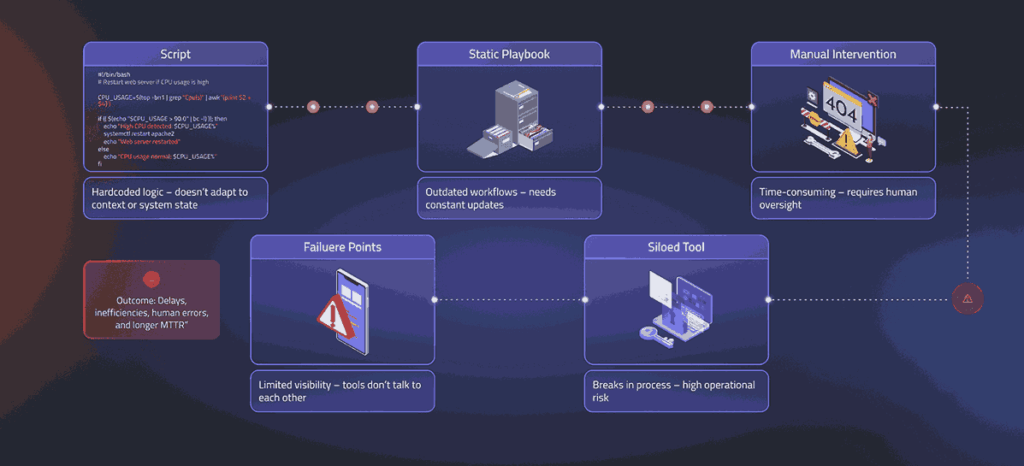In the last decade or so, network infrastructure has undergone a massive transformation. With the rise of hybrid cloud, distributed applications, and software-defined everything, managing networks has become exponentially more complex. What used to be a stable, predictable environment is now a constantly evolving system of interconnected services, protocols, and devices, each with its own telemetry, APIs, and failure models. For network operations (NetOps) teams, this complexity is a daily obstacle to productivity and performance, one that increasingly calls for intelligent automation to keep pace.
The Limits of Traditional Automation vs. Intelligent Automation
Legacy approaches to automation, such as shell scripts, static playbooks, or hardcoded workflows, were never designed to handle the dynamic nature of today’s infrastructure, making the case for intelligent automation even stronger. These tools lack context. They execute fixed commands based on predefined inputs, regardless of whether the situation has changed.
They’re brittle by design, and maintaining them is a burden. Every time an API changes, a tool gets replaced, or a network topology shifts, automation breaks. That leaves operators stuck in reactive mode, constantly fighting fires or rewriting fragile scripts just to keep up.
And what’s the result? Repetitive tasks consume valuable engineering time. Troubleshooting requires significant manual effort. There is little to no room for innovation. The modern networking team is not only overworked but underpowered. This is a potentially catastrophic combination.

AI Agents: The Next Step in Intelligent Automation
To address the growing gap between operational complexity and human capacity, the industry is turning toward AI Agents: intelligent software entities that can perceive, reason, and act autonomously within a system.
In network operations, an AI agent is more than a fancy bot. It is a purpose-built automation engine that can:
- Understand what’s happening across the network
- Evaluate multiple courses of action based on data and logic
- Take context-aware, corrective action in real time
- Continuously learn from new inputs and experiences
This shift moves us from a model of static automation to one of intelligent automation and adaptive intelligence, where agents not only execute tasks but also make informed decisions.
Why Network Teams Need AI Agents Now
Networks aren’t just getting bigger. They are getting more fragile, more interdependent, and more dynamic. It’s no longer feasible for humans to monitor every system, analyze every signal, or respond to every alert in real time. Even the most experienced teams are overwhelmed by alert fatigue, noise, and pressure to maintain uptime and performance.
AI agents offer a path forward, helping NetOps teams:
- Scale intelligently, without proportional headcount increases
- Reduce mean-time-to-resolution, especially in multi-domain outages
- Automate routine tasks like diagnostics, remediation, and config management
- Make smart decisions, thanks to access to real-time telemetry and tooling
But to realize this potential, AI agents need a framework. They need access to tools, data, and services. More importantly, they need a way to dynamically interact with those tools, data, and services without constant human configuration.
This is where the Model Context Protocol (MCP) comes in.
What is the Model Context Protocol?
The Model Context Protocol, or MCP, is a flexible architectural layer that allows AI agents to discover, understand, and interact with external tools in real time. It acts as a context engine and a tool registry, providing a bridge between the agent’s reasoning engine and the services it needs to interact with, whether that’s a REST API, a database, or a file handler.
Unlike traditional integrations that require hardcoded logic or manual wiring, MCP enables:
- Dynamic tool discovery: Agents can see which tools are available at run time
- Contextual access: Tools are described semantically, so agents can understand what each tool does
- Loose coupling: Tools can be added or removed without breaking the system
This flexibility is essential for intelligent automation. Modern networks are constantly evolving, and new tools, services, and platforms are being introduced regularly. MCP allows AI Agents to adapt without requiring rewrites or reconfiguration every time the landscape shifts.

Laying the Foundation for Autonomy
Think of MCP as the foundation of an AI-powered operating model. It creates a universal interface between intelligent agents and the operational tools they need to perform real work.
With MCP in place, AI agents don’t need to be preprogrammed with the details of every API or integration. They can reason about what’s available, choose the right tool, and use it in the right way – in real-time.
But access is only the beginning. To unlock the full potential of intelligent automation, agents must be able to reason through problems, evaluate complex workflows, and take action with confidence.
That’s what we’ll explore in our next post, so make sure to follow us on LinkedIn or X and subscribe to our YouTube channel as we continue our series on AI agents.